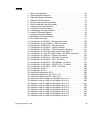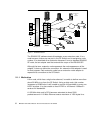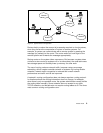
© Copyright IBM Corp. 1998 3
Chapter 1. Dependent Node
This chapter provides an overview of a
dependent node
in RS/6000 SP. We
start by defining the dependent node and the rationale behind its design.
1.1 Dependent Node Architecture
The Dependent Node Architecture refers to a processor or node, possibly not
provided by IBM, for use with the RS/6000 SP.
Since a dependent node may not be a regular RS/6000 SP node, not all the
functions of a node can be performed on it, which is why it is called
"dependent". For example, it does not allow all the functions of the fault
service (Worm) daemon, as other RS/6000 SP nodes with access to the SP
Switch do.
The objective of this architecture is to allow the other processors or hardware
to easily work together with the RS/6000 SP, extending the scope and
capabilities of the system.
The dependent node connects to the RS/6000 SP Switch (but not to the
earlier High Performance Switch, HiPS).
The SP Switch Router Adapter is the first product to exploit the Dependent
Node Architecture.
1.2 Limitations of the Dependent Node
The following are limitations associated with use of the dependent node:
• To use the dependent node in an RS/6000 SP requires the SP Extension
Node SNMP Manager to be installed in the Control Workstation. The SP
Extension Node SNMP Manager requires UDP port 162 in the Control
Workstation. Other SNMP managers, such as Netview, also require this
port. To allow the two SNMP managers to coexist, the SP Extension Node
SNMP Manager must use an alternative UDP port.Dependent nodes are
not allowed in Node Groups.
• Only the 8-port and 16-port SP Switch are supported. The 8-port and
16-port High Performance Switch (the old SP Switch) are not supported.
• The
spmon command on the RS/6000 SP is not enhanced to support
dependent nodes. Dependent nodes can only be viewed with the
perspectives command.


















